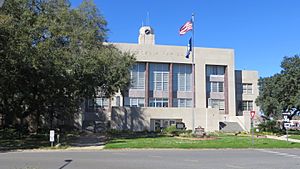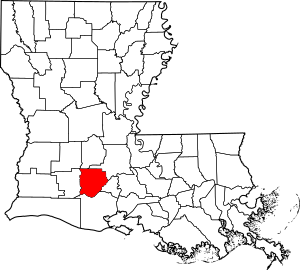Acadia Parish, Louisiana facts for kids
Quick facts for kids
Acadia Parish
|
|
|---|---|

Acadia Parish Courthouse
|
|

Location within the U.S. state of Louisiana
|
|
 Louisiana's location within the U.S. |
|
| Country | |
| State | |
| Founded | June 30, 1886 |
| Named for | The Acadians |
| Seat | Crowley |
| Largest city | Crowley |
| Area | |
| • Total | 657 sq mi (1,700 km2) |
| • Land | 655 sq mi (1,700 km2) |
| • Water | 2.3 sq mi (6 km2) 0.4% |
| Population
(2020)
|
|
| • Total | 57,576 |
| • Density | 87.63/sq mi (33.836/km2) |
| Time zone | UTC−6 (Central) |
| • Summer (DST) | UTC−5 (CDT) |
| Congressional district | 3rd |
Acadia Parish (French: Paroisse de l'Acadie) is a special type of county called a parish in the U.S. state of Louisiana. In 2020, about 57,576 people lived here. The main town and biggest city is Crowley.
Acadia Parish was created in 1886 from parts of St. Landry Parish. Later, the people voted to choose their main town. Crowley won against Rayne and Prairie Hayes. Acadia Parish is part of the larger Lafayette city area.
Contents
History of Acadia Parish
The name "Acadia" comes from a former French colony in Canada. This colony included places like Nova Scotia and New Brunswick today. After Britain won a war against France, they took over these lands. The British asked the French-speaking people, called Acadians, to promise loyalty. Many Acadians were then forced to leave their homes.
Some of these Acadians moved to the French colony of Louisiana. This big move was known as the Great Upheaval. These Acadians became known as Cajuns.
Acadia Parish was formed from the southwestern part of St. Landry Parish, Louisiana. On May 19, 1886, a bill was introduced to create a new parish. Father Joseph Anthonioz suggested the name "Acadia Parish." The bill passed and was approved by Governor Samuel D. McEnery on June 30, 1886.
On October 6, the people voted to confirm the new parish. Most votes were in favor of creating it. The new parish had about 10,000 to 12,000 people. By 1890, the population grew to 13,231.
On March 1, 1887, Crowley was chosen as the parish seat. It received more votes than Rayne and Prairie Hayes. The first leaders of the parish were also chosen then. The first courthouse in Crowley was finished on June 30, 1888. It was used until 1902 when a new building was built.
Geography of Acadia Parish
Acadia Parish covers about 657 square miles. Most of this area, about 655 square miles, is land. A small part, about 2.3 square miles, is water.
Main Roads
 Interstate 10
Interstate 10 U.S. Highway 90
U.S. Highway 90 U.S. Highway 190
U.S. Highway 190 Louisiana Highway 13
Louisiana Highway 13 Louisiana Highway 35
Louisiana Highway 35 Louisiana Highway 91
Louisiana Highway 91 Louisiana Highway 92
Louisiana Highway 92 Louisiana Highway 95
Louisiana Highway 95 Louisiana Highway 97
Louisiana Highway 97 Louisiana Highway 98
Louisiana Highway 98 Louisiana Highway 365
Louisiana Highway 365 Louisiana Highway 370
Louisiana Highway 370 Louisiana Highway 1111
Louisiana Highway 1111
Neighboring Parishes
- Evangeline Parish (north)
- St. Landry Parish (northeast)
- Lafayette Parish (east)
- Vermilion Parish (south)
- Jefferson Davis Parish (west)
Communities in Acadia Parish
Cities
Towns
Villages
Other Areas
Some areas are not officially cities, towns, or villages. These include:
- Arceneaux
- Bates
- Bluff
- Castile
- Deshotel
- Ebenezer
- Ellis
- Evangeline
- Frey
- Gatte's Cove
- Gumpoint
- Hundley
- Judd
- Keystone
- LeJeune Cove
- Link
- Little Japan
- Lyons Point
- Maxie
- Mermentau Cove
- Millerville
- Mire
- Mowata
- Peach Bloom
- Pitreville
- Pointe Noire
- Prairie Hayes
- Prudhomme
- Richard
- Ritchie
- Robert's Cove
- Rork
- Shortbread
- Tepetate
- Tortue
- Tee Mamou
- Whitehouse
- Williams
People of Acadia Parish
| Historical population | |||
|---|---|---|---|
| Census | Pop. | %± | |
| 1890 | 13,231 | — | |
| 1900 | 23,483 | 77.5% | |
| 1910 | 31,847 | 35.6% | |
| 1920 | 34,820 | 9.3% | |
| 1930 | 39,326 | 12.9% | |
| 1940 | 46,260 | 17.6% | |
| 1950 | 47,050 | 1.7% | |
| 1960 | 49,931 | 6.1% | |
| 1970 | 52,109 | 4.4% | |
| 1980 | 56,427 | 8.3% | |
| 1990 | 55,882 | −1.0% | |
| 2000 | 58,861 | 5.3% | |
| 2010 | 61,773 | 4.9% | |
| 2020 | 57,576 | −6.8% | |
| U.S. Decennial Census 1790–1960 1900–1990 1990–2000 2010–2013 |
|||
| Race | Number | Percentage |
|---|---|---|
| White (not Hispanic) | 44,115 | 76.62% |
| Black or African American (not Hispanic) | 9,946 | 17.27% |
| Native American | 145 | 0.25% |
| Asian | 163 | 0.28% |
| Pacific Islander | 2 | 0.0% |
| Other/Mixed | 1,564 | 2.72% |
| Hispanic or Latino | 1,641 | 2.85% |
In 2020, there were 57,576 people living in Acadia Parish. There were 22,236 households, which are groups of people living together.
Most people in the parish are white (76.62%). About 17.27% are Black or African American. A small number of people are Native American, Asian, or Pacific Islander. About 2.85% of people are Hispanic or Latino.
Many people in Acadia Parish have French heritage (about 27.4%). Other common backgrounds include German, English, and Irish. About 10% of people in the parish speak a language other than English at home.
Most homes in Acadia Parish are owned by the people living in them (71.1%). The average household has about 3.31 people. About 26.2% of households have children under 18. The average home value was $118,000.
Arts and Culture
Acadia Parish is known for its many festivals and cultural events. These include the International Rice Festival in Crowley and the Frog Festival in Rayne. You can enjoy delicious Cajun food and lively Cajun music at these events.
Some communities in Acadia Parish celebrate Courir de Mardi Gras. During this tradition, people wear masks and costumes. They travel through rural areas, singing and dancing, and asking for ingredients to make gumbo. The gumbo is then shared at a big community meal and dance.
Education in Acadia Parish
Acadia Parish has many schools run by the Acadia Parish Schools.
- Acadia Parish Head Start - Church Point
- Church Point Elementary (grades PK-5) (Church Point)
- Church Point Middle (grades 6–8) (Church Point)
- Church Point High (grades 9–12) (Church Point)
- Acadia Parish Head Start - Rayne
- Central Rayne Kindergarten (grades PK-1) (Rayne)
- Martin Petitjean Elementary (grades 1–3) (Rayne)
- South Rayne Elementary (grades 4–5) (Rayne)
- Armstrong Middle (grades 6–8) (Rayne)
- Rayne High (grades 9–12) (Rayne)
- Acadia Parish Head Start - Crowley
- Crowley Kindergarten (grades PK-K) (Crowley)
- North Crowley Elementary (grades K-5) (Crowley)
- Ross Elementary (grades K-5) (Crowley)
- South Crowley Elementary (grades K-5) (Crowley)
- Crowley Middle (grades 6–8) (Crowley)
- Iota Elementary (grades PK-5) (Iota)
- Iota Middle (grades 6–8) (Iota)
- Iota High (grades 9–12) (Iota)
- Acadia Parish Head Start - Estherwood
- Branch Elementary (grades PK-8) (Branch)
- Egan Elementary (grades PK-8) (Egan)
- Estherwood Elementary (grades PK-7) (Estherwood)
- Evangeline Elementary (grades PK-8) (Evangeline)
- Mermentau Elementary (grades PK-7) (Mermentau)
- Mire Elementary (grades PK-8) (unincorporated Rayne)
- Morse Elementary (grades PK-7) (Morse)
- Richard Elementary (grades PK-8) (unincorporated Church Point)
- Crowley High (grades 9–12) (unincorporated Crowley)
- Midland High (grades 8–12) (unincorporated Midland)
There are also five Catholic schools in Acadia Parish:
- St. Francis School (grades PK-8) (Iota)
- Rayne Catholic Elementary School (grades PK-8) (Rayne)
- St. Michael Elementary School (grades PK-8) (Crowley)
- Our Mother of Peace Elementary School (grades PK-8) (Church Point)
- Notre Dame High School (grades 9–12) (Crowley)
One private school also serves the parish:
- Northside Christian School (grades PK-12) (Crowley)
For higher education, Acadia Parish has:
- Louisiana State University, Eunice (Eunice)
- South Louisiana Community College (Acadian Campus in Crowley)
The Acadia Parish Library has branches throughout the parish.
National Guard
C Company 3-156TH Infantry Battalion is located in Crowley, Louisiana. This unit has been deployed to Iraq twice.
Notable People
Many interesting people have come from Acadia Parish:
- Tommy Casanova (born 1950), a former professional football player.
- Wayne Toups (born 1958), a popular Cajun musician and singer.
- Jo-El Sonnier (1946–2024), a country and Cajun singer and accordion player.
- George Stanley (1903–1970), a sculptor who helped design the famous Oscar statue.
- Rosie Ledet (born 1971), a Creole and zydeco musician and singer.
- Taylor Ri'chard (born 1980), a film director and screenwriter.
- Mary Alice Fontenot (1910–2003), a journalist and author of children's books.
- Johnnie Allan (born 1938), a musician and singer who helped create the swamp pop music style.
- Edwin Edwards (1927–2021), a former Governor of Louisiana.
- Tony Robichaux (1961–2019), a successful college baseball coach.
- Chris John (born 1960), a former U.S. Representative.
- John Breaux (born 1944), a former U.S. Representative and U.S. Senator.
See also
 In Spanish: Parroquia de Acadia para niños
In Spanish: Parroquia de Acadia para niños


